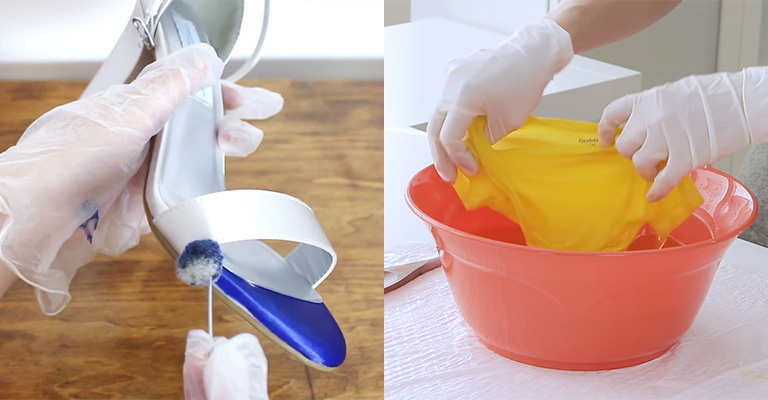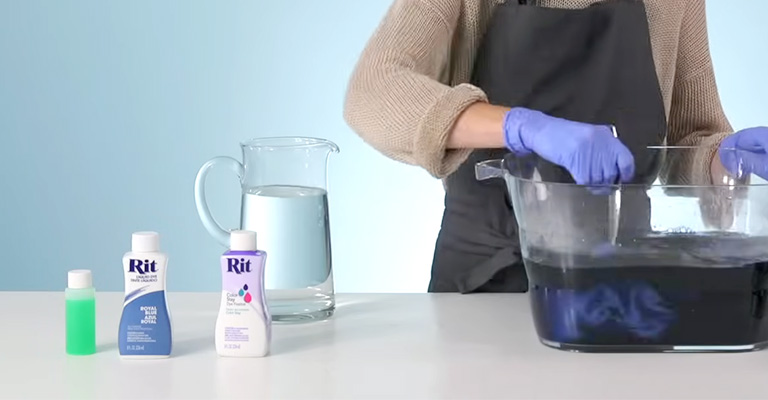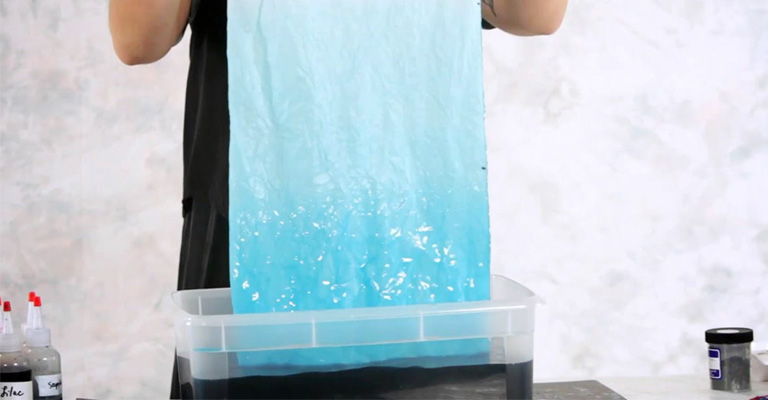Satin is synonymous with luxury and sophistication, adorning everything from glamorous gowns to elegant home decor. But what if you want to refresh or customize your satin items in vibrant, unique colors?
Dyeing satin can be a creative and cost-effective way to breathe new life into your wardrobe or enhance your interior decor. So, how to dye satin shoes, dresses, or curtains?
In this comprehensive guide, we will walk you through the art of dyeing satin, whether it’s shoes that need a fresh look, a special dress craving a color transformation, or curtains seeking a style upgrade.
Unlock the secrets of satin dyeing, and discover how you can add a personal touch to your satin possessions, elevating them to new heights of beauty and individuality.
Whether you’re a DIY enthusiast or just looking to revive your favorite satin pieces, this guide will help you achieve stunning results.

How to Dye Satin Shoes, Dress, or Curtains?
Dyeing satin items like shoes, dresses, or curtains can be a fun and creative way to refresh your wardrobe or home decor. Here’s a step-by-step guide on how to dye satin successfully:
Materials You’ll Need
Satin item to be dyed (shoes, dress, curtains), fabric dye in your chosen color, large plastic container or stainless-steel pot, salt (for some fabric dyes), rubber gloves, stirring utensil, plastic drop cloth or old towel, plastic bags, plastic squeeze bottles (optional), and plastic bucket (for rinsing).
Prepare Your Workspace and Satin Item
Lay down a plastic drop cloth or old towel to protect your work surface. Put on rubber gloves to protect your hands from the dye. Ensure the satin item is clean and free from any stains or dirt.
If you’re dyeing a dress or curtains, you may need a large container or pot big enough to accommodate them. For shoes, a smaller container will suffice.
Mix the Dye and Test the Color
Follow the instructions on the fabric dye package to mix it with water. Some dyes may require the addition of salt. You can also use plastic squeeze bottles to apply the dye for more precise control.
Before dyeing the entire item, it’s a good idea to test the color on a small, inconspicuous area to ensure you’re happy with the result.
Dye the Satin
Immerse the satin item into the dye bath or use the squeeze bottles to apply the dye evenly. Stir the item continuously to ensure even color absorption. Be mindful of the dyeing time; the longer you leave the item in the dye, the darker the color will be.
Rinse and Wash
Once you’ve achieved the desired color, rinse the satin item thoroughly with cold water until the water runs clear. Wash the item separately with mild detergent to remove any excess dye.
Follow the care label instructions for washing satin. Otherwise, harsh laundry detergent might damage the fabric.
Dry Properly and Iron
Hang your dyed satin dress or curtains to air dry, away from direct sunlight. For satin shoes, stuff them with paper towels to help them maintain their shape and allow them to air dry.
Once your satin item is dry, give it a final inspection to ensure the dyeing process was successful. Steam or iron the item if necessary to remove wrinkles and restore its elegance.
Dyeing satin can be a rewarding DIY project, but it requires careful attention to detail and patience. With the right materials and a creative spirit, you can transform your satin items into stunning, personalized pieces that reflect your unique style.
What Can I Use to Dye Satin Shoes, Dresses, or Curtains?

The right materials and products, combined with proper technique and careful attention to detail, will allow you to successfully dye satin items, transforming them into unique and vibrant pieces that suit your style and preferences.
Always follow the specific dye manufacturer’s instructions to achieve the best results. To dye satin shoes, dresses, or curtains, you will need the following materials and products:
Fabric Dye
Choose a high-quality fabric dye specifically designed for the type of stain you’re working with. Popular options include Rit All-Purpose Dye, iDye Poly (for synthetic satin), or Procion MX (for natural fiber satin).
Make sure the dye is suitable for the satin’s fiber content (synthetic or natural) and is available in your desired color.
Salt or Fixative (Optional)
Depending on the type of dye you use, you may need to add salt or a fixative to enhance colorfastness. Salt is typically used with fiber-reactive dyes, while a fixative like vinegar or citric acid may be needed for acid dyes. Follow the dye manufacturer’s instructions regarding the use of these additives.
Rubber Gloves and Plastic Container
Protect your hands from coming into direct contact with the dye by wearing rubber gloves. This helps prevent staining and skin irritation.
Choose a container or pot large enough to comfortably accommodate the satin item you plan to dye. Ensure it is non-reactive and won’t interact with the dye. Stainless steel, plastic, or enamel pots are good choices.
Stirring Utensils and Plastic Drop Cloth
Use a non-reactive stirring utensil such as a plastic spoon, stainless steel rod, or even a wooden stick to mix the dye and stir the satin item in the dye bath.
Lay down a plastic drop cloth or an old towel to protect your work surface from potential dye spills or splatters. This makes cleanup much easier.
Plastic Squeeze Bottles (Optional)
If you want more precise control over the application of dye, consider using plastic squeeze bottles. These are particularly handy when creating patterns or adding multiple colors to dresses or curtains.
Plastic bags can be used to cover and protect areas of the satin item that you don’t want to dye. For example, when dyeing satin shoes, you can use bags to cover the soles or any embellishments you want to preserve.
Plastic Bucket (for rinsing) and Mild Detergent
After the dyeing process is complete, you’ll need a plastic bucket for rinsing the dyed item. Rinse it thoroughly with cold water until the water runs clear to remove excess dye.
Use a gentle, mild detergent to wash the dyed satin item after rinsing. This helps remove any residual dye and ensures the fabric is clean and ready for use.
Hangers (for dresses and curtains) and Paper Towels (for shoes)
If you’re dyeing satin dresses or curtains, you’ll need hangers to hang them for drying. Hanging the items while drying helps prevent creases and wrinkles.
When dyeing satin shoes, stuff them with paper towels to help maintain their shape and absorb any excess moisture while they dry.
What Dye to Use for Satin Fabric?

The choice of dye for satin fabric depends on the fiber content of the satin—whether it’s natural or synthetic. Here are recommendations for both types:
For Natural Fiber Satin (such as silk or cotton satin)
- Acid Dye: Acid dyes are ideal for natural fiber satin. They work well with silk and cotton satin and provide vibrant, long-lasting colors. These dyes require the addition of an acid, such as vinegar or citric acid, to set the color. Brands like Jacquard Acid Dyes are popular choices.
- Procion MX Dye: Procion MX dyes are fiber-reactive dyes that are suitable for natural fibers like silk. They bond chemically with the fabric, resulting in durable and vibrant colors. These dyes require soda ash as a fixative.
For Synthetic Fiber Satin (such as polyester or nylon satin)
iDye Poly
iDye Poly is a polyester dye designed specifically for synthetic fabrics like polyester or nylon satin.
It offers excellent color saturation and adherence to synthetic fibers. This dye simplifies the dyeing process for satin made from synthetic materials.
Rit DyeMore
Rit DyeMore is another option for synthetic satin. It’s formulated to work well with polyester, nylon, and other synthetic fibers. It comes in a variety of colors and is easy to use.
When selecting a dye, be sure to check the dye manufacturer’s instructions and recommendations, as well as the dye’s compatibility with your specific satin fabric. Additionally, consider factors such as the color you want to achieve and whether you prefer liquid or powder dye.
Remember to perform a colorfastness test on a small, inconspicuous area of your satin fabric before dyeing the entire item. This test will help ensure that you’re happy with the color and that the dye adheres properly to the satin.
Follow the dyeing instructions carefully, and you’ll be able to transform your satin fabric into the desired shade with confidence.
FAQs
Can I dye satin fabric at home?
Yes, you can dye satin fabric at home using fabric dye specifically formulated for the type of satin you have—natural or synthetic. Follow the dye manufacturer’s instructions and take proper precautions to achieve the best results.
Do I need to pre-wash the satin fabric before dyeing it?
It’s advisable to wash the satin fabric before dyeing it. This helps remove any sizing, dirt, or residues that might interfere with the dyeing process and ensures even color absorption.
Can I mix different dye colors to create a custom shade?
Yes, you can mix different dye colors to create a custom shade. However, it’s essential to follow the dye manufacturer’s recommendations for mixing proportions to achieve the desired color accurately.
How do I prevent uneven dyeing or splotches on satin fabric?
To prevent uneven dyeing or splotches, ensure that the fabric is evenly submerged in the dye bath and constantly agitate or stir the fabric. Follow the recommended dyeing time and process meticulously.
Can I dye a dark-colored satin fabric to a lighter color?
Dyeing a dark-colored satin fabric to a lighter color can be challenging, as the existing color might affect the outcome. It’s generally easier to achieve a lighter color on a lighter or white satin fabric.
You may need to use a color remover or bleach before dyeing in such cases.
Conclusion
Embarking on the journey of dyeing satin shoes, dresses, or curtains has unlocked a world of possibilities for you. As we conclude this guide, it’s worth reflecting on the transformation you can achieve with a little creativity and some expert guidance.
By following the steps outlined in this comprehensive guide, you’ve learned that dyeing satin is not just about changing colors; it’s about reinventing elegance.
Whether you’ve revitalized worn-out shoes or given a cherished dress a fresh identity, you’ve harnessed the power to breathe new life into satin.
Remember, the key to successful satin dyeing lies in careful preparation, choosing the right dye, and mastering the dyeing process itself. With patience and attention to detail, you can achieve vibrant, personalized results that reflect your unique style.
As you enjoy the fruits of your dyeing endeavors, may your satin items continue to be a canvas for your creativity and an expression of your individuality.
Leave a Reply